Share

Invisible Not Broken - Chronic Illness Podcast Network
Diagnosing fibromyalgia by physical exam and the power of the guaifenesin protocol - Dr. Congdon and Eva of Wellacopia
TITLE: Diagnosing fibromyalgia by physical exam and the power of the guaifenesin protocol - Dr. Congdon and Eva of Wellacopia
Diagnosing fibromyalgia by physical exam - Dr. Congdon and Eva of Wellacopia
(for the artwork only)
---
Get matched with your perfect practitioner at Wellacopia.com
If you are unable to find a good match in your location yet, Eva will do the personalized matching for you anywhere in the USA.
Text: 1-646-883-3022 or Email: Contact@Wellacopia.com
To contact or learn more from Dr. Melissa Congdon, please visit MelissaCongdonMD.com
---
- What is your profession?
I am a physician who treats children and adults with fibromyalgia. I am a board-certified pediatrician who was in private practice for 18 years until severe fibromyalgia symptoms forced me to retire from medicine. After going on the guaifenesin protocol and getting acupuncture my symptoms dramatically declined, enabling me to return to practice medicine 20 months after I “retired.” My fibromyalgia doctor, Dr. Paul St. Amand at Harbor UCLA medical center suggested that I not go back to practicing general pediatrics but become a fibromyalgia consultant instead. I trained with him and have been doing fibromyalgia consulting for children and adults since 2010.
- What is your illness(es)?
Fibromyalgia
- Where do you work?
The San Francisco Bay Area
- Who do you work with?
I am in solo practice, but I communicate with my mentor Dr. St. Amand frequently. I also keep in touch with many integrative medicine providers and other health care practitioners to share insights about treatments and ways to help patients feel better
- How did your illness shape your career?
I was sick for a long time before I was diagnosed with fibromyalgia. I have severe fatigue, dizziness, 15 migraines a month, chronic neck and shoulder pain, and irritable bowel symptoms. I thought surely I must be dying because I felt so sick and doctors could not figure out what was wrong with me. My children were young at this time, and I hoped that I would not pass away until my youngest was at least 7 years old, because I thought by that age she would remember her mother’s love. So I have been to that dark hopeless place that chronic illness can lead a person to, and I went from mostly housebound to feeling well again. My illness motivated me to help others do the same. It feels so good to feel good again!
- What do you do when you don't know what to do about a patient?
First I like to think and meditate about it, then if I can’t come up with a treatment plan I will reach out to my network of healthcare providers to get insight.
- Are you/were you open about your illness with patients?
YES. My patients tell me it is a great help to them that I truly understand what it feels like to have fibromyalgia (physically and emotionally), and that that is one of the reasons they have chosen me to help them feel better.
- What are you most passionate about in regards to your work?
Two things. First of all, how to make an accurate diagnosis by physical exam, and no, I am not talking about the inaccurate tender point exam. My mentor, Dr. Paul St. Amand, taught me how to diagnose fibromyalgia using a physical exam technique called “mapping.” He has found that everyone with fibromyalgia has a pattern of very small swollen and contracted muscles along their left anterior thigh. He taught me how to detect them, and if a patient has these swellings, then they have fibromyalgia! It is not complicated! These swellings are so small and are not tender, so most people with fibromyalgia don't realize they are there -- but they are super easy to feel once you have been trained in this technique.
Secondly, I love helping people with fibromyalgia decrease their pain, improve their mood, and increase their energy. There are a lot of helpful tips I can give them to achieve this, but one of the most life changing treatments I have found for fibromyalgia is the guaifenesin protocol. Guaifenesin is an expectorant (it is the active ingredient in Mucinex) and used in the right form (long acting dye free guaifenesin) and avoiding products that can block its action, guaifenesin can decrease our muscle spasm and pain over time (as well as increase energy, improve mood, intestinal function, etc). After I dramatically improved using the guaifenesin protocol, my mentor taught me how to administer the protocol to others. It has been so successful patients thank me every month for giving them their lives back! I feel so thankful to have found the guaifenesin protocol and thankful for the opportunity to help others with fibromyalgia feel better.
- How do you/did you handle flares while at work?
I am able to set my own schedule, so if I need more down time I insert a break in my schedule.
- How do you did you handle being a patient and a professional in your personal life?
When I am at work I am focusing on my patient, and I only bring up my personal experiences if my patient asks.
- Do you tell your patients what you tell yourself / do you practice what you preach? For the most part! I am committed to helping my patients feel better, and sometimes I spend more than the allotted time for the appointment answering patient’s questions. This can cause me to miss lunch!
- Has your condition made you more or less empathetic to those like you?
MORE empathetic! I have come to understand that some healthcare professionals do not believe fibromyalgia is a real medical condition. They think that we are depressed, or stressed, or just lazy. I even heard one rheumatologist refer to Fibromyalgia as “The F word!” I KNOW fibromyalgia is real because I feel the symptoms (plus there are hundreds of studies indicating that those of us with fibromyalgia have unique physical and biochemical findings). I am passionate about helping validate my patients symptoms and help empower them to get the care they deserve.
- How do you research conditions? on your own? drug companies? medical journals? Colleagues? how do you convey this knowledge to patients?
Every morning I go on a physician's site called Doximity to check what new research has been done on fibromyalgia, I also Google fibromyalgia and get a compendium of articles from various sources about what is happening the field of fibromyalgia and chronic pain. I talk to colleague regularly, I post every Tuesday on my professional FB page (usually sharing new research results or an article about fibromyalgia) and I send out newsletters on a regular basis to my patients updating them on the latest developments in the field.
- How do you feel about holistic medicine? what does it mean to you?
The definition of holistic medicine I like best is that Holistic medicine is a form of healing that considers the whole person -- body, mind, spirit, and emotions -- in the quest for optimal health and wellness. ... In this way, if people have imbalances (physical, emotional, or spiritual) in their lives, it can negatively affect their overall health. This is from WebMD. I use the most natural methods and techniques with the fewest side effects when I treat my patients.
- Tell us about a special experience with a patient (uplifting)
Ahh, Stefanie comes to mind. She is a wildlife biologist who developed pain as a child. Her doctors couldn't figure out what was wrong with her. She was having so many migraines and so much pain in her body her doctors told her “well, you are just one of those people with pain.” After 9 months on the guaifenesin protocol she felt a “dramatic decrease” in the pain she was in an increase in energy, so much so that she was able to do more and have the confidence to have a baby, and she did! To see her in the office holding her baby in her arms was so amazing. She said her improvement on guaifenesin “feels like a miracle, it just transformed my life.” There are so many stories like Stefanie’s of symptom improvement on the guaifenesin protocol! I produced a documentary called Fibromyalgia: Getting Our Lives Back--Success Stories on the Guaifenesin Protocol: https://www.youtube.com/watch?v=DtPPoOBeXTM for people who want to learn more.
- If you had one message to send out to every chronic illness patient out there what would it be?
Don’t give up! You are not alone! Keep searching to find your tribe-- supportive healthcare practitioners that are experts in your condition and who are committed to working hard to help you feel better.
The documentary Fibromyalgia: Getting Our Lives Back—Success Stories on the Guaifenesin Protocol: https://www.youtube.com/watch?v=DtPPoOBeXTM
Dr. St. Amand’s website: http://www.fibromyalgiatreatment.com/
Dr. St. Amand’s book What Your Doctor May Not Tell You About Fibromyalgia: http://www.fibromyalgiatreatment.com/books-and-dvds.html and https://www.amazon.com/What-Your-Doctor-About-Fibromyalgia/dp/1455502715/ref=pd_lpo_sbs_14_t_0?_encoding=UTF8&psc=1&refRID=0PKW88RSY6AXQDFFF0C1 This is the link to the latest edition
Online Guaifenesin Support Group: http://www.fibromyalgiatreatment.com/online-support-group.html
Fibromyalgia Facebook Support Group for those on the Guaifenesin Protocol: https://www.facebook.com/groups/fibrofightersonguaifenesin/?epa=SEARCH_BOX
Where to purchase guaifenesin and personal care products that do not block guaifenesin’s action: http://www.fibropharmacy.com/
Websites devoted to selling salicylate free products: https://www.andrearose.com/sensitive-skin-care-basics-s/100.htm and https://www.cleure.com/Default.asp
Note: It is common to feel intermittently worse during the first 4 months on the protocol. We are here with tips to help you feel better during this time.
More episodes
View all episodes
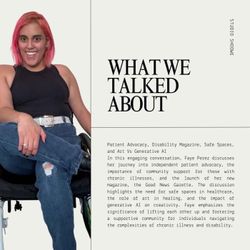
Faye: Patient Advocacy, Disability Magazine, Safe Spaces, and Art Vs Generative AI
36:55|Faye: Patient Advocacy, Disability Magazine, Safe Spaces, and Art Vs Generative AIPatient Power & Joy: Affordable Advocacy, Safe Spaces & Why Community Beats AI Art | FayeYouTube Description (Long-Form SEO & Social Media Ready)Are you tired of navigating the broken healthcare system alone? 💔In this uplifting and essential episode, we reconnect with the incredible Faye to dive deep into Independent Patient Advocacy. This conversation is your guide to feeling heard and supported in your health journey, combining practical advocacy tips with empowering discussions on community and creativity.What We Cover & Why You Need to Listen:02:49 - Patient Power: Understanding the crucial Role of Independent Patient Advocacy and how it can literally change your health outcomes.05:57 - Healthcare Hacks: Practical strategies for Navigating the Healthcare System and avoiding medical gaslighting.11:46 - Affordable Support: Learn about The Butterfly Guild and how they are providing vital, affordable advocacy services for chronic illness patients.14:34 - Positive Vibes: Discover The Good News Gazette—a source of light and hope in the often-dark world of chronic illness. ✨22:26 - Art vs. AI: A fascinating discussion on the Importance of Real Art Over AI and the unique value of human creativity in the disability space. 🎨27:42 - Find Your Tribe: The undeniable Value of Community in the chronic illness journey and how we can build Supportive Community for All.This episode is a must-listen for chronic illness patients, caregivers, advocates, and anyone interested in healthcare reform and the powerful impact of human connection.LISTEN NOW! 👇independent patient advocacy, affordable advocacy services, butterfly guild, navigating the healthcare system, patient safe spaces, medical gaslighting, chronic illness community, chronic illness support, disability advocacy, healthcare reform, joy and community, art vs ai, human creativity, aging and authenticity, universal income for artists, chronic illness podcast, patient empowerment, good news gazette, Faye, health advocacy tips, systemic healthcare issues.#PatientAdvocacy #ChronicIllnessWarrior #SpoonieLife #AffordableAdvocacy #HealthcareHacks #MedicalGaslighting #CommunitySupport #ArtVsAI #DisabilityCommunity #HealthPodcast #FindYourTribe #SupportSmallBusiness #ChronicLife #JoyThroughArt #HealthTech #ButterflyGuild #PatientPower 💪🦋🧠💻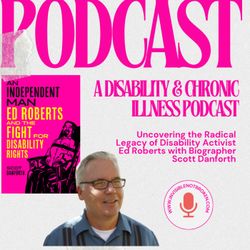
Uncovering the Radical Legacy of Disability Activist Ed Roberts with Biographer Scot Danforth
50:59|Uncovering the Radical Legacy of Disability Activist Ed Roberts with Biographer Scott DanforthKeywordsEd Roberts, disability rights, activism, biography, independence, community, technology, publishing, women in activism, accessibilityTakeawaysEd Roberts was a pivotal figure in the disability rights movement.His activism began at UC Berkeley with the Rolling Quads.The fight for disability rights is ongoing and requires constant vigilance.Family dynamics play a crucial role in fostering independence for disabled individuals.Community building is essential for effective activism.Technology can greatly enhance accessibility for disabled individuals.The Center for Independent Living was a groundbreaking initiative for disability rights.Women played a significant but often overlooked role in the disability rights movement.Writing a biography involves difficult choices about what to include or exclude.The publishing process can be challenging, especially for underrepresented stories.SummaryThis conversation explores the life and legacy of Ed Roberts, a pivotal figure in the disability rights movement. Scott Danforth, the author of a biography on Roberts, discusses the challenges and triumphs of advocating for disability rights, the importance of community and independence, and the role of technology in enhancing accessibility. The conversation also touches on the often-overlooked contributions of women in the movement and the complexities of writing a biography. Danforth shares insights from his research and the publishing process, emphasizing the need for continued advocacy and the importance of storytelling in the fight for disability rights.TitlesUnveiling Ed Roberts: A Disability Rights PioneerThe Legacy of Ed Roberts and Disability ActivismSound bites"This is not a very well-known man.""He had polio as a teenager.""He loved the technology."Chapters00:00 Introduction to Ed Roberts and His Legacy02:13 The Fight for Disability Rights09:07 Independence and Family Dynamics14:53 Building Community and Activism21:28 Technological Advancements and Accessibility26:57 Revitalizing the Center for Independent Living27:24 The Legacy of Ed Roberts and Disability Activism28:23 Unveiling the Myths of Disability Leadership30:49 The Unsung Heroes of the Disability Rights Movement31:54 Chronic Illness and the Overlooked Voices33:30 The Joys and Challenges of Writing a Biography35:21 The Process of Research and Writing36:17 Editing and Storytelling in Biography38:44 Navigating the Publishing Landscape41:25 The Journey into Disability Studies43:58 Dreams vs. Reality in Disability Advocacy46:46 The Importance of Community and Creativity48:23 Joy as Resistance in Activism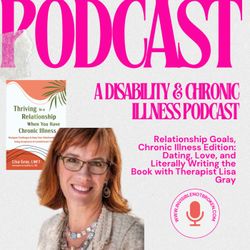
Relationship Goals, Chronic Illness Edition: Dating, Love, and Literally Writing the Book with Therapist Lisa Gray
43:45|Keywordschronic illness, relationships, conflict resolution, empathy, writing process, power imbalance, emotional management, self-help, therapy, communicationSummaryIn this conversation, Lisa Gray, a marriage and family therapist, discusses the complexities of relationships when chronic illness is involved. She shares insights on conflict resolution, the importance of empathy, and how to navigate power imbalances in relationships. Lisa also delves into her writing process, the significance of finding meaning in chronic illness, and practical tools for writing and publishing. The discussion emphasizes the need for understanding, communication, and the ability to adapt in relationships affected by chronic illness.TakeawaysConflict increases intimacy if done right.Healthy conflict means knowing your partner better.Stop fighting when you're already mad.Impulse control is key in managing conflict.Power imbalances can affect relationships with chronic illness.Empathy must go both ways in relationships.Finding meaning is crucial in the grieving process.Values can guide actions despite chronic illness.Writing can be a therapeutic process.Use tools that work for your energy levels.TitlesNavigating Relationships with Chronic IllnessThe Art of Healthy ConflictSound bites"Empathy needs to go both ways.""Intimacy is very broad.""Weighted blankets are so comforting."Chapters00:00 Introduction to Chronic Illness and Relationships02:55 Navigating Conflict in Relationships06:02 Impulse Control and Managing Emotions09:07 Power Imbalances in Relationships11:54 Empathy in Chronic Illness Relationships14:57 Core Skills for Managing Chronic Illness17:42 Finding Meaning and Values in Relationships20:55 Personal Discoveries Through Writing23:55 Building Empathy Through Curiosity24:15 Exploring Virtual Reality and Empathy25:39 Relationships and Support in Chronic Illness28:05 Intimacy and Chronic Illness30:30 The Writing Process and Tools for Writers38:58 Publishing Insights and ResourcesTranscript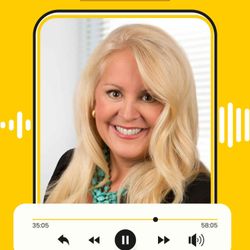
Navigating the Patient Journey with Author Brenda Snow
41:00|SummaryIn this conversation, Brenda Snow shares her personal journey as a patient diagnosed with multiple sclerosis and discusses her book, 'Diagnosed: The Essential Guide to Navigating the Patient Journey.' She emphasizes the universal experience of navigating chronic illness, the importance of grief and acceptance, and the need for strong doctor-patient relationships. Brenda also highlights the significance of maintaining one's identity while caregiving and the power of storytelling in healing. The discussion concludes with advice for aspiring writers and the importance of sharing personal narratives.Chapters00:00 Introduction to Brenda Snow and Her Journey02:49 The Universal Patient Experience06:48 Navigating Grief and Acceptance12:41 The Doctor-Patient Relationship20:42 Identity and Caregiving26:12 Finding Growth in Adversity31:56 The Power of Storytelling35:40 Advice for Aspiring Writers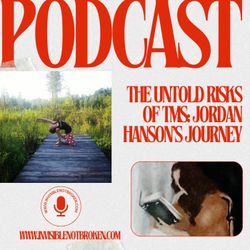
The Untold Risks of TMS: Jordan Hanson's Journey
01:00:05|KeywordsTMS, transcranial magnetic stimulation, brain injury, mental health, medical gaslighting, patient advocacy, chronic illness, technology in healthcare, self-care, mindfulnessSummaryIn this conversation, Jordan Hanson shares her personal journey with transcranial magnetic stimulation (TMS), a procedure intended to treat mental health issues. She discusses the initial excitement about the treatment, the subsequent negative effects she experienced, and the challenges of navigating the medical system. The conversation highlights the importance of patient advocacy, community support, and the role of technology in managing health. Jordan emphasizes the need for awareness and understanding of the risks associated with TMS and the importance of self-care and mindfulness in coping with chronic illness.TakeawaysTMS is a procedure that uses magnetic fields to stimulate brain activity.Jordan experienced significant negative effects from TMS, including brain injury symptoms.Medical gaslighting is a common issue faced by patients seeking help.Community support is crucial for those dealing with chronic illness.Technology, including AI, can assist in managing health and communication.Self-care and mindfulness are essential for coping with chronic illness.Advocacy is important to raise awareness about the risks of TMS.Family planning can be complicated by health issues and uncertainties.Understanding the impact of chronic illness on daily life is vital.The journey of healing is ongoing and requires patience and support.TitlesThe Hidden Risks of TMS: A Personal JourneyNavigating the Medical Maze: Jordan's TMS ExperienceSound bites"I was called headache girl for a year.""I want to share my story to help others.""I have to protect myself and my energy."Chapters00:00 Introduction to TMS and Jordan's Journey01:13 Understanding the Impact of TMS on Life01:28 Introduction and Background on TMS04:20 Understanding Trans-Cranial Magnetic Stimulation (TMS)07:23 The Experience of TMS Treatment10:20 The Impact of TMS on Daily Life13:09 Medical Gaslighting and Patient Advocacy16:13 The Journey to Recovery and Diagnosis19:14 Community Support and Sharing Stories22:18 The Decision to Create a Documentary25:13 Advocacy and Future Goals36:11 The Need for Scientific Understanding in TMS40:42 Coping with Chronic Illness and Disability44:52 Navigating Family Planning Amidst Uncertainty52:54 Leveraging Technology for Brain Injury Support59:42 Personal Growth Through Adversity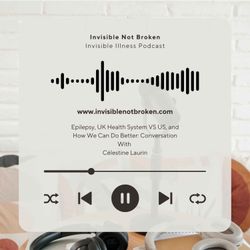
Epilepsy, UK Health System VS US, and How We Can Do Better: Conversation With Célestine Laurin
01:20:40|Epilepsy, UK Health System VS US, and How We Can Do Better: Conversation With Célestine LaurinSummaryIn this conversation, the speakers delve into the complexities of living with epilepsy and chronic illness, particularly focusing on the experiences of children and young adults. They discuss the challenges of diagnosis, the importance of support from family and friends, and the role of therapy in managing mental health. The conversation also touches on the stigma surrounding chronic illness, the impact of bullying, and practical advice for managing seizures and advocating for oneself in educational and social settings. Additionally, they explore how epilepsy is represented in the media and the need for better understanding and communication around the condition. This conversation delves into the complexities of living with epilepsy, particularly focusing on the challenges faced by women regarding medication and pregnancy. The speakers share personal experiences with the impact of epilepsy on their lives, careers, and the healthcare system. They discuss the stigma surrounding chronic illness, the importance of open communication with clients in business, and the differences in healthcare systems across countries. The conversation highlights the need for greater awareness and understanding of disability and chronic illness. In this conversation, the speakers discuss the challenges faced by individuals with disabilities, the impact of overprotection on children, and the need for inclusive spaces and universal design. They explore the healthcare systems in different countries, highlighting the disparities in access and affordability. The conversation emphasizes the importance of disability advocacy in health policy and the need for a more inclusive approach to legislation that considers the needs of all individuals, particularly those with chronic illnesses.Keywordsepilepsy, chronic illness, mental health, therapy, support, bullying, childhood illness, accommodations, media representation, epilepsy, medication, women’s health, chronic illness, disability, healthcare, personal stories, photography, career choices, mental health, disability, healthcare, universal design, overprotection, advocacy, inclusivity, chronic illness, education, mental health, accessibility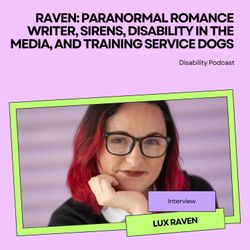
Raven: Paranormal Romance Writer, Sirens, Disability in the Media, and Training Service Dogs
52:33|Chapters00:00 Introduction to Romance Writing and Disability05:49 Life Changes During the Pandemic11:53 Writing Romance with Chronic Illness17:55 Representation of Disability in Romance24:35 The Viral Success of a Romance Novel31:07 Writing as a Form of Self-Discovery36:06 Navigating Writing with Disabilities49:59 The Journey of Training a Service DogSummaryIn this conversation, the speakers delve into the intersection of romance writing and disability representation, particularly focusing on the experiences of chronically ill individuals. They discuss the impact of the pandemic on their lives, the process of writing romance novels that feature disabled characters, and the importance of authentic representation in literature. The conversation also touches on the viral success of one speaker's romance novel, the emotional journey of writing, and the practical challenges of writing with disabilities. Additionally, they explore the journey of training a service dog and how it has positively influenced their lives.TakeawaysThe pandemic led to significant life changes and new diagnoses.Writing romance novels became a creative outlet during difficult times.There is a need for authentic representation of disabled characters in romance.Readers appreciate seeing themselves reflected in literature.The success of a romance novel can be validating for writers.Writing can be a form of self-discovery and healing.Navigating the writing process with disabilities requires adaptation and support.Service dogs can provide emotional and physical support for their owners.Community and connection are vital for those with chronic illnesses.The journey of self-publishing can be empowering despite challenges.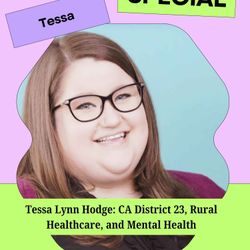
Tessa Lynn Hodge: CA District 23, Rural Healthcare, and Mental Health
53:55|SummaryIn this conversation, Tessa Lynn Hodge discusses her journey from being a licensed clinical social worker to running for office in District 23. She emphasizes the importance of community engagement, healthcare reform, and the need for authenticity in politics. Tessa shares her experiences and insights on the challenges faced by her community, particularly in rural areas, and highlights the significance of mental health accessibility and telehealth. Her campaign focuses on putting people over party and advocating for grassroots funding to ensure real change.Keywordsdisability, politics, healthcare, community, mental health, grassroots, Tessa Lynn Hodge, election, advocacy, social work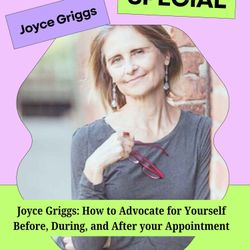
Joyce Griggs: How to Advocate for Yourself Before, During, and After your Appointment
50:25|Keywordshealth advocacy, patient empowerment, healthcare system, self-advocacy, doctor visits, healthcare resources, United States of Healthcare, patient stories, healthcare challenges, AI in healthcareSummaryIn this conversation, Joyce Griggs shares her journey into health advocacy, highlighting the challenges faced by patients in navigating the healthcare system. She discusses the importance of self-advocacy, preparing for doctor visits, and managing the dynamics between patients and healthcare providers. Joyce emphasizes the need for personalized care and the role of technology, including AI, in shaping the future of healthcare. The discussion also touches on the systemic issues within the healthcare system and the importance of community support and resources for patients.TakeawaysAdvocacy is crucial for navigating the healthcare system.Patients often face significant challenges in getting proper care.Self-advocacy is an essential skill for all patients.Preparing for doctor visits can improve outcomes.Emotional management is key before healthcare appointments.Bias exists in healthcare, affecting patient treatment.Community support can empower patients in their advocacy efforts.AI has potential benefits and risks in healthcare decision-making.Personalized care is necessary for effective treatment.Understanding insurance processes can help patients advocate for themselves.TitlesNavigating the Healthcare Maze: A Journey of AdvocacyEmpowering Patients: The Role of Self-AdvocacySound bites"We need to be our own advocates.""We are the experts of ourselves.""Personalized care is essential."Chapters00:00 Introduction to Health Advocacy02:54 Personal Journey into Healthcare Advocacy05:53 Navigating the Healthcare System08:25 Building the United States of Healthcare11:34 Resources for Health Advocacy14:23 Preparing for Doctor Visits17:07 Managing Emotions in Healthcare19:48 Interviewing Healthcare Providers22:49 Addressing Systemic Issues in Healthcare28:02 Navigating Healthcare Access Challenges30:38 Addressing Power Imbalances in Healthcare34:26 The Impact of Bias in Medical Treatment35:22 Evolving Perspectives in Medicine37:23 Utilizing Technology for Patient Advocacy42:04 Building Community and Support46:51 Envisioning a Better Healthcare System50:20 end cap.mp4